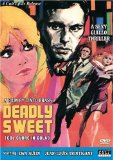Jean-Louis Trintignant (here dubbed into Italian) is a hard-boiled actor (!). Arriving at a night club to meet the proprietor, he instead finds the man dead, and the luscious Ewa Aulin standing over the corpse, protesting her innocence. Trintingnant believes her, and decides to help her out. The quest for the truth leads them though a series of encounters with various aspects of London nightlife and lowlife, 1967 vintage.
This early Tinto Brass effort is nominally a thriller, though, as he himself points out on the commentary track, the film is only vaguely interested in its thriller aspects. The big influence here is Antonioni’s Blow Up, which is name-checked a couple of times. Deadly Sweet has the same kind of meandering plot and love of lingering over various examples of Swinging London counterculture. The other guiding muse is comic book artist Guido Crepax, and Brass mimics comic panels with multiple split screens, shifts between colour and black-and-white, and the like. It is an open question whether all of these games work at a cinematic level, but they are certainly visually interesting. The films is, like so many of its contemporaries, self-indulgent, but in a rather endearing way. For my money, it’s a more engaging viewing experience than many of the erotica exercises from the director’s mature period.
One quick note: the running time indicated on the case is 105 minutes. In fact, it is 99.
Video
The 1.85:1 anamorphic widescreen transfer looks quite youthful. There is some digital grain and pixellation in some of the darker scenes, especially those saturated in red lighting, but the print itself is very fine. The colours and contrasts are strong, as are the blacks, and the black-and-white tones look very good. Print grain is almost non-existent (except where deliberately employed), and there is no edge enhancement to speak of.
Audio
The soundtrack is the original mono, and a pretty snazzy mono it is. Sure, there are the usual post-sync oddities, but that has nothing to do with the transfer. What really stands out is the psychedelically groovy rock score, which pounds out pretty nicely indeed.
Commentary Track: Tinto Brass is quite articulate here on what he was trying to achieve with the film. He is fully aware that this was a youthful, experimental piece, and he seems quite fond of it for that very reason. He comes across as a man with a very deep love of his medium.
Special Features
Lobby Card Gallery.
Trailer.
Final Thoughts
A nice package of what might be, for this reviewer, the most fun of all the Tinto Brass films released thus far. But if ever a film cried out for an accompanying CD soundtrack, this is it.





